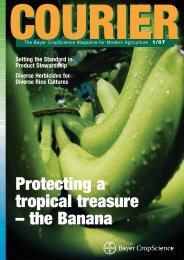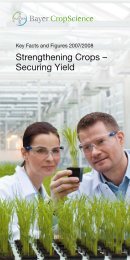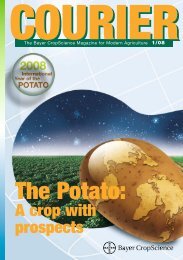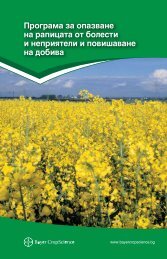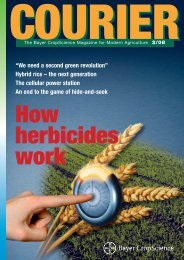For healthy potatoes - Bayer CropScience
For healthy potatoes - Bayer CropScience
For healthy potatoes - Bayer CropScience
You also want an ePaper? Increase the reach of your titles
YUMPU automatically turns print PDFs into web optimized ePapers that Google loves.
future<br />
Globally farming faces giant challenges:<br />
old challenges remain, namely how to<br />
increase food and fibre production in<br />
response to the inexorable rise in population.<br />
At the same time population and<br />
income growth, coupled with dietary<br />
diversification, are changing food consumption<br />
patterns and add to the overall<br />
burden placed on natural resources such as<br />
land, water, energy and biodiversity. The<br />
need for rural development, including getting<br />
the knowledge and means of applying<br />
locally appropriate technologies across to<br />
millions of small scale growers in emerging<br />
economies, also continues. Often this<br />
is hampered by market entry hurdles at<br />
local level or barriers to market access at<br />
international level. But this is not all:<br />
newer challenges such as climate change<br />
will have a direct effect on agriculture and<br />
the consequent pressure to switch to cleaner<br />
energy sources, such as biofuels, raises the<br />
question of whether land and other<br />
resources can be spared for this purpose.<br />
Over the past 100 years world population<br />
has more than trebled to over 6 billion<br />
and forecasts predict an increase to almost<br />
8 billion by 2025. Over the past half century<br />
food production has more than kept<br />
pace with human numbers, but the annual<br />
increase in farm productivity is predicted<br />
to slow from an average 2.2 percent over<br />
the past three decades to 1.5% in the<br />
period until 2030. This is still ahead of<br />
expected population growth, but alongside<br />
growing human numbers, changes in<br />
lifestyle and dietary habits fostered by economic<br />
development is boosting the<br />
demand for high value food products.<br />
Large increases in meat, fruit and vegetable<br />
consumption are projected, and yet<br />
animal proteins, kilogram for kilogram,<br />
require almost three times as much in<br />
terms of natural resources to produce as<br />
traditional starchy foods.<br />
Shortages of natural resources such as<br />
water, soil, energy and biodiversity add to<br />
the overall challenge. The bottom line is<br />
that approximately 90% of the required<br />
increase of agricultural production must<br />
come from yield increases on existing<br />
farmland, which at the same time is also<br />
the best way to protect biodiversity. However<br />
a recent IFPRI study (2002) concluded<br />
that soil degradation due to erosion,<br />
nutrient depletion and salinisation affects<br />
70% of the world’s cropland, and is severe<br />
on 30-40%. Fresh water demand is estimated<br />
to have risen more than six-fold<br />
from 1900 to 1995 while population<br />
growth “only” doubled during the same<br />
period. Water use in agriculture accounts<br />
for some 70% of all water use worldwide<br />
and thus water shortages have been identified<br />
as likely to be the single most significant<br />
constraint on crop production over the<br />
next 50 years. If current use trends continue<br />
agriculture will require double water<br />
use by 2050. Almost 12% of the earth’s<br />
land surface is covered by protected areas,<br />
which exceeds the global target of 10% set<br />
in 1992. Nonetheless, ecosystems continue<br />
to be degraded. Since space is limited<br />
strategies to conserve biodiversity can<br />
not just be confined to protected areas.<br />
Conservation objectives must be firmly<br />
embedded into agricultural practices.<br />
What makes the productivity issue even<br />
more critical are aspects such as climate<br />
change. <strong>For</strong>ecasted global temperature<br />
increases of between 1.4 and 5.8°C by the<br />
end of this century will impact on farming,<br />
e.g. as wheather extremes will regularly<br />
occur. Emerging economies with a high<br />
dependence on agriculture will be particularly<br />
affected according to a recent study<br />
published jointly by the Food and Agriculture<br />
Organization (FAO) and the International<br />
Institute of Applied Systems Analysis<br />
(IIASA). These countries could experience<br />
an 11% decrease in cultivable, rainfed<br />
land with consequent decline in cereal<br />
production. In contrast North America,<br />
Northern Europe, the Russian Federation<br />
and East Asia may see a significant potential<br />
to expand their crop area and increase<br />
production of cereals. Climate change will<br />
also influence the development and intensification<br />
of plant pests (insects, pathogens<br />
and weeds) caused by changing ecological<br />
conditions, which will have to be addressed<br />
at an accelerating pace, often not<br />
leaving much time to find effective and<br />
appropriate pest control solutions.<br />
Recent developments such as the sharp<br />
rise in oil prices, the need for cleaner alternative<br />
energy sources and the requirement<br />
to reduce carbon emissions under the Kyoto<br />
protocol have led to a boom for biofuels:<br />
bioethanol and biodiesel. Production is<br />
increasing rapidly in Europe, the Americas,<br />
Thailand, India, Australia and elsewhere<br />
based on crops as diverse as corn,<br />
soybeans, rapeseeds, sunflowers, coconuts<br />
and sugar cane. What makes biofuels so<br />
compelling is the fact that conventional car<br />
engines can run on them without any major<br />
change and thus they offer an advantage<br />
over hydrogen powered cars, which can<br />
only be used with a more complex technology.<br />
To date Brazil’s 20 million cars<br />
already run on 25 percent bioethanol.<br />
While the technology is straightforward<br />
the politics are more complex: would<br />
energy crops take too much space away<br />
from food crops badly needed to feed the<br />
growing population and would it also put<br />
biodiversity and other natural resources<br />
under even more pressure<br />
2/06 COURIER 25





